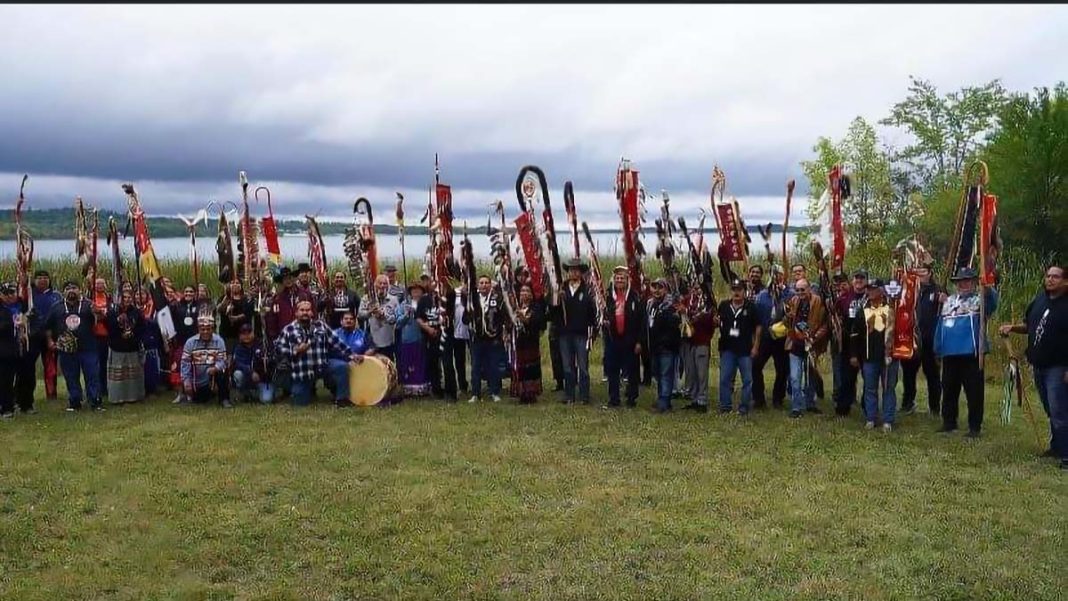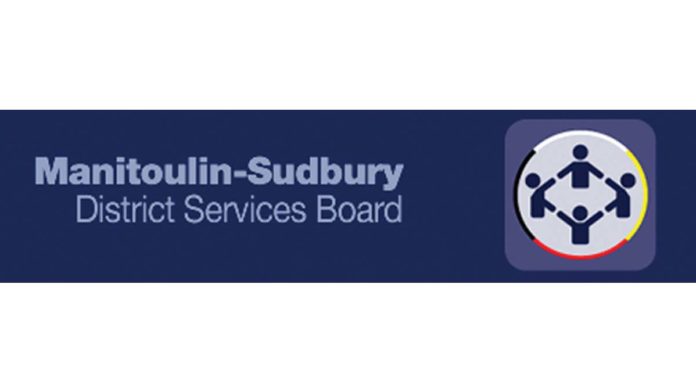SHEGUIANDAH—As the procession of community eagle staffs made their way across the Sheguiandah First Nation powwow grounds to the Sheguiandah Round House a pair of eagles could be seen soaring high overhead. Among those bearing the staffs were elders, veterans and community and regional leaders. They were joined by numerous water carriers, Anishinaabe-kwe bearing the copper kettles and cups of their calling. Many had travelled great distances to celebrate the Sheguiandah First Nation Gathering of the Eagle Staffs.
The eagle staff is the emblem of a community encompassing the honour and memory of a community’s veterans and are usually carried by a veteran or important figure in a community. The eagle staff embodies the culture and traditions of a community and is unique to that community. At its base, an eagle staff is constructed out of wood from a tree that has been struck by lightning—touched by the Thunderbird—and usually is adorned by at least one eagle feather. As a unique emblem of a community an eagle staff bears symbols that have come to the creator of the staff through vision and connection to the land and the teachings behind each staff are shared during an eagle staff gathering. Eagle staffs far predate the flags that were brought to Turtle Island by the incoming settlers.
If there is an overarching theme to eagle staff gatherings it is unity, bringing Anishinaabe communities together. It was a theme touched upon by each of the speakers who addressed the gathering following the grand entry.
There were 70 eagle staffs registered for the gathering, each representing a community or organization and bearing symbols evoking sacred truths about their communities. Throughout the gathering,speakers provided overviews of the teachings encompassed within
Anishinabek Nation Grand Council Chief Reg Niganobe pointed out the 39 feathers adorning the shaft of the Anishinabek Nation Eagle Staff, one for each community in the council. “One feather is facing away from the others,” he said, pointing out that as communities with different interests and outlooks there are occasions when they did not all agree. “One feather is in a different direction than the others,” he said, noting that although they didn’t always agree, “It’s okay. We are all still together.”
Former Wiikwemkoong Unceded Territories ogimaa Duke Peltier began his address in Anishnaabemowin, switching to English to relate the story of how he met during the last eagle staff gathering in Gun Lake First Nation with one getzit (Gordon Waindubence baa, traditionally refraining from speaking his name aloud too soon after the elder began his spirit journey). “He expressed a desire to have such a gathering in his home community, in the round house,” recalled Mr. Peltier, adding it was unfortunate that he was not able to live to see the procession enter the round house that morning.
“You have all paid for the eagle staff,” he said. “I’m not talking zhoonyah (money).” Instead, he noted, the payment was in the dreams, the visions and in “sitting on the land to learn about how to put the staffs together.”
Mr. Peltier recalled the late elder’s “twinkle in his eye, silent little chuckle and little grin” before looking him “straight in the eye and sharing what his thoughts were.”
Following their chat, Mr. Peltier reached out to then-Grand Council Chief Glen Hare to set the wheels in motion.
“We tried in 2020, we tried in 2021,” he said, “but we are here today.”
Mr. Peltier offered great thanks to the Waindubence family and Chop Waindubence, Gordon’s son, for taking up the challenge of making the gathering a reality.
“He wanted to come,” said Mr. Waindubence during his remarks. “He really did. He gave me a lot of instruction, a lot of time. He said the most important thing is that the people are together. I know he is looking down on us and having a good laugh at all the little details that we are forgetting.”
Mr. Waindubence noted that the eagle staffs, standing side-by-side in the circle in the centre of the round house, were symbolic of the nations. “No borders, no boundaries between us,” he said. Boundaries and border are constructs of the settler nations, said Mr. Waindubence, attempts to isolate and separate the nations from each other, an effort that the eagle staff gatherings show has failed.
Gun Lake elder and veteran George Martin was unable to attend the gathering in Sheguiandah, but his son Jeff Martin came as a representative of the family. He spoke of his father and his dreams for the gatherings, interrupting his speech for a moment to invite a youth to speak.
“This is why we do this,” said Mr. Martin following the youth’s short address in Anishnaabemowin.
Each of the staff bearers were gifted with bundles of cloth as each of the staffs and their bearers were recognized before breaking for lunch.
Throughout the next two days the teachings behind each eagle staff were related during the day, with intertribal dances every hour for health breaks. Noosdin drum group provided the songs.
Entertainment was provided in the evening by Johnny Cash Tribute Band on Friday and Dwayne Trudeau on Saturday.
Each morning began with a sunrise ceremony and an assembly of the eagle staffs at the sacred fire before a grand entry into the round house.
Concurrent with the Eagle Staff gathering a four-day Fire Keepers Gathering was held at the South Bay Centre with guest speakers Alex Bisson, Brian Peltier, Alison Recollet and Howard Trudeau. The Fire Keeper gathering was held for those interested in learning more about the duties and responsibilities learning about the sacred position sacred fires play a central role in funerary rites and gatherings of all types in Anishinaabe culture and traditions.




